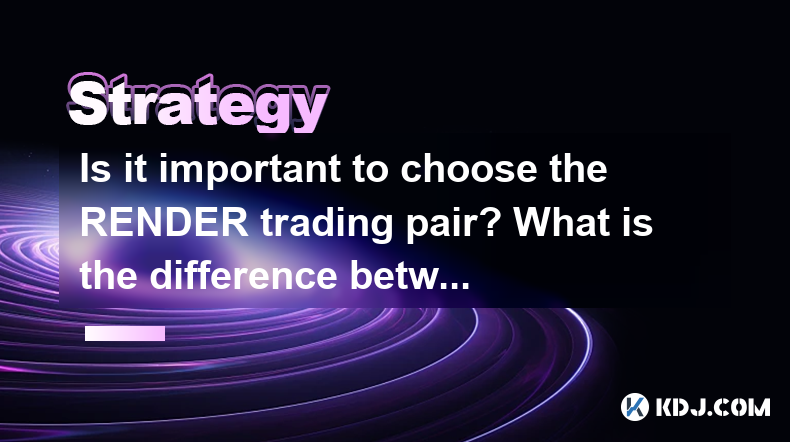-
 bitcoin
bitcoin $115692.075601 USD
5.13% -
 ethereum
ethereum $4162.931611 USD
11.68% -
 bnb
bnb $1310.063287 USD
17.56% -
 tether
tether $1.000983 USD
0.00% -
 xrp
xrp $2.534505 USD
8.16% -
 solana
solana $198.235737 USD
13.49% -
 usd-coin
usd-coin $1.000236 USD
0.02% -
 dogecoin
dogecoin $0.207352 USD
12.89% -
 tron
tron $0.323043 USD
3.62% -
 cardano
cardano $0.701559 USD
11.88% -
 hyperliquid
hyperliquid $39.924597 USD
8.30% -
 chainlink
chainlink $18.934457 USD
11.56% -
 ethena-usde
ethena-usde $1.000552 USD
0.02% -
 stellar
stellar $0.340575 USD
7.05% -
 bitcoin-cash
bitcoin-cash $545.011757 USD
8.86%
Is it important to choose the RENDER trading pair? What is the difference between mainstream currency pairs and small currency pairs?
Choosing the RENDER trading pair can impact your trading due to its liquidity, volatility, fees, and market sentiment. Consider mainstream vs. small pairs based on your goals and risk tolerance.
May 03, 2025 at 12:07 pm

When venturing into the world of cryptocurrency trading, selecting the right trading pair can significantly impact your trading experience and outcomes. One such trading pair that traders often consider is the RENDER trading pair. In this article, we will explore the importance of choosing the RENDER trading pair and delve into the differences between mainstream currency pairs and small currency pairs.
Why Choose the RENDER Trading Pair?
The RENDER trading pair refers to a specific cryptocurrency pair where one of the currencies involved is RENDER. Choosing the right trading pair is crucial for several reasons:
Liquidity: The RENDER trading pair often offers high liquidity, which means there is a substantial volume of trading activity. High liquidity ensures that you can enter and exit trades quickly and at a price close to the market rate.
Volatility: RENDER pairs can exhibit different levels of volatility. Some traders prefer volatile pairs for the potential of higher returns, while others may opt for less volatile pairs for more stable trading.
Trading Fees: Different exchanges may charge varying fees for trading the RENDER pair. Selecting a pair with lower fees can significantly impact your overall profitability.
Market Sentiment: The choice of trading pair can also reflect market sentiment towards RENDER. If there is strong interest in RENDER, trading pairs involving it may be more active and potentially more profitable.
Mainstream Currency Pairs vs. Small Currency Pairs
Understanding the differences between mainstream and small currency pairs is essential for making informed trading decisions.
Mainstream Currency Pairs
Mainstream currency pairs are those that involve widely recognized and highly traded cryptocurrencies. Examples include Bitcoin (BTC), Ethereum (ETH), and Tether (USDT). The characteristics of mainstream currency pairs include:
High Liquidity: Mainstream pairs generally have high liquidity due to their popularity and the large number of traders involved.
Lower Volatility: These pairs tend to be less volatile compared to smaller pairs, offering more stability for traders.
Lower Trading Fees: Exchanges often charge lower fees for trading mainstream pairs because of the higher trading volumes.
Broader Market Access: Mainstream pairs are available on nearly all cryptocurrency exchanges, making them easily accessible to traders worldwide.
Small Currency Pairs
Small currency pairs, on the other hand, involve less popular or newer cryptocurrencies. These might include altcoins or tokens with smaller market capitalizations. Key characteristics of small currency pairs include:
Lower Liquidity: Small pairs often have lower liquidity, which can result in larger spreads and more difficulty in executing trades at desired prices.
Higher Volatility: These pairs can be more volatile, offering the potential for higher returns but also higher risks.
Higher Trading Fees: Due to lower trading volumes, exchanges may charge higher fees for trading small pairs.
Limited Market Access: Small pairs may not be available on all exchanges, limiting the number of platforms where they can be traded.
How to Choose Between Mainstream and Small Currency Pairs
When deciding whether to trade a mainstream or a small currency pair involving RENDER, consider the following factors:
Trading Goals: If your goal is to engage in stable, long-term trading, mainstream pairs might be more suitable. For those seeking higher potential returns and willing to take on more risk, small pairs could be more appealing.
Risk Tolerance: Assess your risk tolerance. Mainstream pairs offer more stability, while small pairs can be more unpredictable.
Market Research: Conduct thorough market research to understand the current trends and sentiment around RENDER and the other cryptocurrency in the pair.
Exchange Availability: Ensure that the chosen pair is available on the exchange you plan to use, as this can impact your trading options.
Practical Steps to Start Trading the RENDER Pair
If you decide to trade the RENDER pair, follow these practical steps to get started:
Select an Exchange: Choose a reputable cryptocurrency exchange that supports trading the RENDER pair. Popular exchanges include Binance, Coinbase, and Kraken.
Create an Account: Sign up for an account on the chosen exchange. You will need to provide personal information and complete any required verification processes.
Deposit Funds: Fund your account with the cryptocurrency you intend to trade against RENDER. This could be Bitcoin, Ethereum, or another supported currency.
Navigate to the Trading Section: Once your account is funded, navigate to the trading section of the exchange. Find the RENDER trading pair you wish to trade.
Place an Order: Decide on the type of order you want to place. Common order types include market orders, limit orders, and stop orders. Enter the amount you wish to trade and confirm the order.
Monitor and Manage Your Trades: Keep an eye on your open positions and market conditions. Adjust your strategy as needed to manage risk and maximize potential returns.
Understanding the Impact of Fees on RENDER Trading
Trading fees can significantly affect your overall profitability when trading the RENDER pair. Here are some tips for managing fees:
Compare Exchanges: Different exchanges charge different fees for trading the RENDER pair. Compare fees across multiple platforms to find the most cost-effective option.
Use Limit Orders: Limit orders can help you control the price at which you buy or sell, potentially saving on fees compared to market orders.
Take Advantage of Promotions: Some exchanges offer fee discounts or promotions for new users or high-volume traders. Look out for these opportunities to reduce your trading costs.
Consider Maker vs. Taker Fees: Some exchanges differentiate between maker and taker fees. Maker orders add liquidity to the market and often have lower fees, while taker orders remove liquidity and may incur higher fees.
FAQs
Q: Can I trade the RENDER pair on decentralized exchanges?A: Yes, some decentralized exchanges (DEXs) support trading the RENDER pair. However, liquidity and trading fees may differ from those on centralized exchanges. Always research the specific DEX to ensure it meets your trading needs.
Q: How does the choice of trading pair affect my tax obligations?A: The choice of trading pair can impact your tax obligations, as different jurisdictions may treat different cryptocurrencies differently. It's essential to consult with a tax professional to understand how trading the RENDER pair might affect your tax situation.
Q: Are there any tools or indicators specifically designed for trading the RENDER pair?A: While there are no tools or indicators specifically designed for the RENDER pair, general trading tools such as moving averages, RSI, and MACD can be applied to analyze the RENDER pair's price movements. These tools can help you make more informed trading decisions.
Q: How can I stay updated on news and developments related to RENDER?A: To stay updated on news and developments related to RENDER, follow official RENDER social media channels, subscribe to relevant cryptocurrency news websites, and join RENDER-focused communities on platforms like Reddit and Telegram.
Disclaimer:info@kdj.com
The information provided is not trading advice. kdj.com does not assume any responsibility for any investments made based on the information provided in this article. Cryptocurrencies are highly volatile and it is highly recommended that you invest with caution after thorough research!
If you believe that the content used on this website infringes your copyright, please contact us immediately (info@kdj.com) and we will delete it promptly.
- XRP Price Prediction: Weekend Rollercoaster or Rally?
- 2025-10-12 08:45:16
- Bittensor (TAO): Super Bullish Signals Point to Potential 2x Rally
- 2025-10-11 10:25:12
- Silver Price Correction: Navigating the Dip & Identifying Key SEO Keywords
- 2025-10-11 10:25:12
- Decoding Crypto Trends: Bittensor's Bull Run, Cardano's Dip, and LivLive's Presale Buzz in 'Uptober 2025'
- 2025-10-12 08:45:16
- MoonBull: The Crypto Meme Coin Promising 1000x Gains?
- 2025-10-11 10:30:01
- Crypto Payroll Revolution: Stablecoins, Altcoins, and the Future of Salary Payments
- 2025-10-11 10:30:01
Related knowledge

Practical parameter settings for a Bitcoin multi-timeframe moving average system
Sep 18,2025 at 10:54pm
Optimizing Timeframe Combinations for Bitcoin Trading1. Selecting appropriate timeframes is crucial when building a multi-timeframe moving average sys...

How can I filter out false breakouts in Dogecoin high-frequency trading?
Sep 22,2025 at 01:00am
Understanding False Breakouts in Dogecoin Trading1. A false breakout occurs when Dogecoin's price appears to move beyond a defined support or resistan...

Techniques for identifying tops and bottoms in the Bitcoin on-chain NVT model
Sep 20,2025 at 07:54pm
Understanding the NVT Model in Bitcoin Analysis1. The Network Value to Transactions (NVT) ratio is often described as the 'P/E ratio' of the cryptocur...

What does the surge in open interest in Bitcoincoin futures mean?
Sep 20,2025 at 11:18pm
Understanding the Surge in Dogecoin Futures Open Interest1. A surge in open interest within Dogecoin futures indicates a growing number of active cont...

How can I use the Ethereum USDT premium to gauge market sentiment?
Sep 18,2025 at 11:55pm
Understanding the Ethereum USDT Premium1. The Ethereum USDT premium refers to the price difference between USDT (Tether) traded on Ethereum-based plat...

What should I do if Ethereum staking yields decline?
Sep 20,2025 at 06:18am
Understanding the Causes Behind Declining Ethereum Staking Yields1. The Ethereum network transitioned to a proof-of-stake consensus mechanism with the...

Practical parameter settings for a Bitcoin multi-timeframe moving average system
Sep 18,2025 at 10:54pm
Optimizing Timeframe Combinations for Bitcoin Trading1. Selecting appropriate timeframes is crucial when building a multi-timeframe moving average sys...

How can I filter out false breakouts in Dogecoin high-frequency trading?
Sep 22,2025 at 01:00am
Understanding False Breakouts in Dogecoin Trading1. A false breakout occurs when Dogecoin's price appears to move beyond a defined support or resistan...

Techniques for identifying tops and bottoms in the Bitcoin on-chain NVT model
Sep 20,2025 at 07:54pm
Understanding the NVT Model in Bitcoin Analysis1. The Network Value to Transactions (NVT) ratio is often described as the 'P/E ratio' of the cryptocur...

What does the surge in open interest in Bitcoincoin futures mean?
Sep 20,2025 at 11:18pm
Understanding the Surge in Dogecoin Futures Open Interest1. A surge in open interest within Dogecoin futures indicates a growing number of active cont...

How can I use the Ethereum USDT premium to gauge market sentiment?
Sep 18,2025 at 11:55pm
Understanding the Ethereum USDT Premium1. The Ethereum USDT premium refers to the price difference between USDT (Tether) traded on Ethereum-based plat...

What should I do if Ethereum staking yields decline?
Sep 20,2025 at 06:18am
Understanding the Causes Behind Declining Ethereum Staking Yields1. The Ethereum network transitioned to a proof-of-stake consensus mechanism with the...
See all articles























![[4K 60fps] Anyway by Retropt (1 Coin) [4K 60fps] Anyway by Retropt (1 Coin)](/uploads/2025/10/13/cryptocurrencies-news/videos/k-fps-retropt-coin/68ec4f42a41d0_image_500_375.webp)


















































